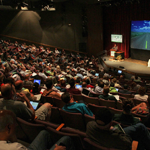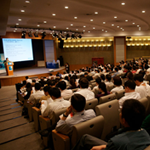For people with disabilities, accessing care can be ‘overwhelming’
At HIMSS21, consultant and patient advocate Laura Jantos will offer personal perspective on the “huge opportunity” to develop tools that help all patients to engage meaningfully with their own care.
Digital health tools can go a long way in making care more accessible for patients, especially those who may have logistical difficulties with analog-heavy systems.
At the same time, it’s vital for health IT developers and stakeholders to recognize how a product’s design may make it more difficult for some people to connect with care – or make it altogether impossible.
Laura Jantos, a healthcare IT consultant and patient advocate, says that the first thing people in the industry should understand about her perspective is that “I am the person in the room as well.”
“I know how hard everyone works,” she said in an interview with Healthcare IT News about her upcoming HIMSS21 session.
Jantos had been leading the healthcare IT practice at a management consulting firm in 2012 when a snowboarding accident left her with a traumatic brain injury and significant cognitive impairment.
The experience of trying to navigate the healthcare system during her recovery gave her the chance to study just how much effort it takes to connect with treatment. “The effort to find and access care you need can be overwhelming,” she said. “It’s challenging for everyone, but if you add disability it’s really challenging.”
As one example, she noted that cognitive impairments can make it extremely difficult to navigate screens.
Trying to do so, she said, often has a physical consequence, including headaches or emotional triggers. “It can happen very quickly, and that can be the only thing you can accomplish in a day,” she said.
As another example, she said, “If I get a paper statement, and I want to pay it online, if the layout of the paper statement and the layout of the online bill don’t match exactly, it can be incredibly challenging.”
As a third, she pointed to the process of refilling a prescription, which can involve multiple steps and hurdles. And trying to get around these points of inaccessibility, she says, can be demoralizing.
“It ends up becoming traumatic,” she said. “There’s a level of anxiety: ‘Why do I have to advocate for something that should be easy?'”
Jantos notes that she has a particular understanding of the healthcare system – so the process with those less familiar is undoubtedly even more frustrating.
“I understand way too much and I do have a lot of patience,” she said. “But, you know, most people don’t understand all the pieces and how they’re supposed to come together.”
So how might innovators ensure patients can participate in their own healthcare?
“People that work in the safety net work on this all the time,” she said. “It’s a very challenging and complicated process.”
She points to telehealth as one potential avenue for supporting patients. But, she says, it’s important not to be limited to video encounters alone.
“We need to make sure we’re meeting people at an appropriate level: phone-based encounters, video, a combination of analog and digital,” she said. The important thing, she says, is the outcome.
“We’ve got to be able to have a variety of different modalities and use them in an appropriate way,” she said.
Overall, she said, “I would urge everyone to take a step back from what we’re designing and try to think about all this from the patients’ perspective – and work really hard to develop tools and systems and processes that … allow the patient to engage meaningfully.”
“There’s a huge opportunity to engage patients in a more effective way,” she said, “And I think that that’s going to lead to much better outcomes and probably much less runaround and waste on all sides.”






























